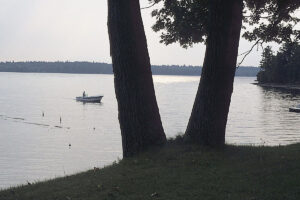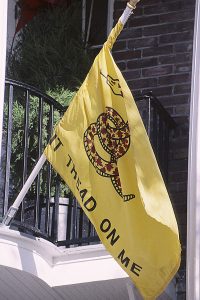Kaj Halberg - writer & photographer
Travels ‐ Landscapes ‐ Wildlife ‐ People
John Andrew Burke (1951-2010)
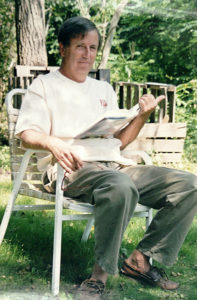

A recent survey revealed that a majority of active American Catholics under the age of 65 do not believe in the central sacrament of the mass – the literal transubstantiation of the bread wafers in to the body and blood of Christ at communion. Why then are they attending mass every Sunday? Do their reasons have more to do with sociology than theology? After all, like so many before and after me, I lost my faith for reasons that were not so much theological as sociological.

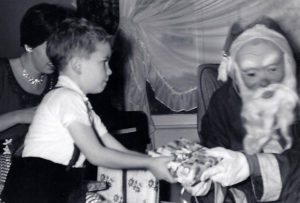
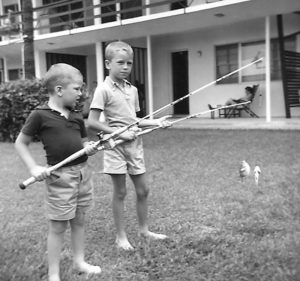
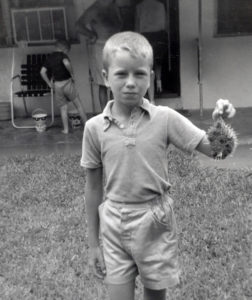
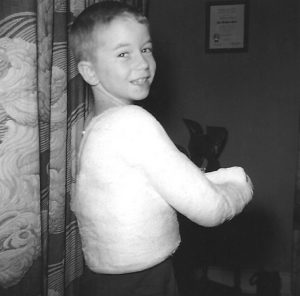
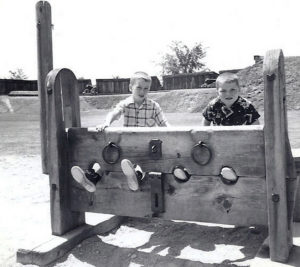
What we did know was that Sister Mary Ruth insisted on afternoon naps – not for us, for her. She’d give us an assignment, switch off her hearing aid, place her head in her hands and pretend to read. Since we never knew anyone who snored while they read, we caught on pretty fast. Her poor hearing meant that sometimes she could tell that someone in a row had been talking, but not exactly whom. If the culprit failed to confess, she was not above extending her hand and walking briskly down the row, slapping every face in turn, sort of Three Stooges style.
We were able to make some estimate of her age the day she decided to teach us about the solar system and its seven planets. When myself and a fellow budding scientist attempted to point out there were nine planets, she got loudly indignant. “Don’t try to tell me, young man! I have it right here in my notes from college. There are seven planets!” So, she had gone to school before the last two were discovered and had not exactly kept up on ‘current’ events.
It was Sister Mary Ruth, in fact, who gave me a second reason for remembering where I was the day JFK was shot. Now, first you have to remember that John Fitzgerald Kennedy, first Catholic President of the United States (and Irish at that) was considered more of a saint than a politician in our schools. So, for us it was that much worse, when someone came to the classroom door with the news that the President had taken three bullets to the head and been rushed to the hospital. We were told to pray silently while Sister Mary Ruth switched on her portable radio and we listened for further word. Now, we didn’t have a P.A. system back then, so someone had to hit every classroom to spread the word. I stress this because twenty minutes into our silent vigil the class across the hall absolutely erupted in laughter. My comic companion across the aisle promptly whispered out of the corner of his mouth, “I guess they got the news!” and I completely lost it. I guess my sense of humor was as black then as it is now, because I laughed uncontrollably – for about 3.5 seconds. My first pause to inhale became a terror-stricken freeze. 65 faces were turned on me, but only one mattered. Sister Mary Ruth’s glower said that I had just committed sacrilege, and she was about to exact the price. (Remember Galileo?) Just like combat veterans hate to talk about battle, I don’t like to discuss what came next.
By the time we became teenagers in a small suburban town, still too young to drive our way out of it, we were inventing new pastimes as we gradually gained the run of the school. As a ‘hobby’, several friends and I amassed a collection of keys for every locked door in the place – keys we used at night, when we made the school ours. Keys for pranks like making the hated music teacher’s piano ‘disappear’. Realizing they might first think theft and call the cops, we left a poem-clue in its place:
1) You just made a tactical error, Sister.
2) Boy, is she gonna be pissed.
There were lots of other pranks. Some brought the police. In general, though, we stayed anonymous, kept them guessing, and basked in the feeling of power that secret knowledge brings. Some of that knowledge, though, exacted a price – our innocence. Using our key to the principal’s office (the only one in existence not on her ring) at night, we stumbled one summer onto a secret letter from the outgoing-with-a-sense-of-humor to our incoming I-haven’t-laughed-in-twenty-years warden. That letter was the first serious crack in my faith. It was an outline for skimming money from the student-supported yearbook and class ring fund – to provide spending money for all the sisters on vacations.
This secret system might have been understandable in a cash-strapped institution, but every year they chewed us students out that no matter how hard we worked raising money for these two projects each year, we always lost money and the school had to bail us out. In other words, we were powerless failures, but they took care of us. Now we knew that the truth in fact was just the opposite, we even checked the books! Every year we had left surpluses, the student treasurer had graduated, and the principal had emptied the funds for pocket money. They would then begin the next year with the same old pitches berating us for our inherent inability to support the only two projects we students tried to finance. This was bad enough, but the fact that it came from one of the warmest-hearted nuns I had ever known was demoralizing. We wished we had never found the letter.

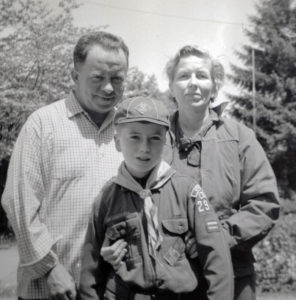

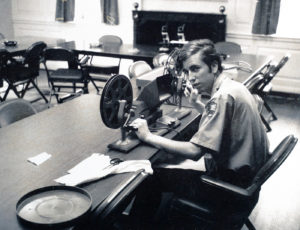
Father Day (names changed to protect the guilty) was the worst priest I ever saw. He hated pastoral work, hated people, let everyone know it and had made it to the age of 45 this way as ‘a man of God’. I worked ‘rectory duty’, answering the phones and door from 7:00 to 11:00 P.M. Tuesdays, and one night I took a memorable emergency call. The priest scheduled to be on duty was out on another call, and someone dying in the middle of Main Street (three blocks away) needed Last Rites. “Hey, it’s not my problem,” Father Day glibly replied, “I’m off duty.” His everyday motto was, “Hey, I just work here!”
The coarseness radiating from this vocational misfit was counterbalanced beautifully by the elegant, diplomatic pastor – Father Cash who truly did care. (He’s the one who later pried me from the grip of the police so to speak.) Father Cash had one bombshell during his tenure, and he dropped it with panache. For twenty years our pastors had been haranguing us for special collections for a boiler, a new roof, etc. We all understood the need, and they assured us the parish was broke so we had to raise the $10,000 or $20,000 now, pronto. One fine spring sermon, Father Cash unveiled a master plan to build a new school, a new gym, a new church. The bad news? This would cost $2.5 million. The good news? We already had $1.5 million in the bank, so if we could just raise one more million, we could…. Whoa! Excuse me! Could we back up there a second? The parish that’s been broke for twenty years has how much in the bank?
While the priests were trying my faith inside the church, the parishioners were slaughtering it outside. One of my first part-time jobs was directing traffic in and out of the overburdened church parking lot. Someone had to ensure that all the cars would use every square foot efficiently, otherwise they’d never fit. So, every Sunday, a high-school friend and I sat outside during each mass, listening to our neighbors’ worship, and embrace “Love thy neighbor as thyself for the love of God.” Before and after this interlude they would threaten to run Frank and me down if we didn’t get out of their way. Nothing quite gets you in the mood for church like a fat-bellied cigar-chewer trying to convince you he is about to break your kneecaps with the grill of his Mercedes, unless you get out of the way and let him have the parking spot that will make his walk fifty feet shorter.
All of these trials, however, dimmed in comparison to Father Imbroglio – an obese man who vacationed in Hawaii. “Boys, have you ever heard of poi? 4,000 calories per ounce! And fat people are considered beautiful there!” No one held his obesity against him, hell, he was a great cook. But his love of thin, adolescent boys was another thing entirely. It was no accident that he was a dedicated Athletic Director who loved spending time in the locker room.


My faith was almost saved ‘in the nick of time’ by a truly wonderful Catholic institution called retreat. Half the boys in our class were taken to a mountain-top monastery upstate for a three-day stay. A man’s man of a brother talked to us and pulled no punches. He was captivating. He was real. And the rhythms of the place had their own special impact. Up early for mass, followed by a communal breakfast of all-you-could-eat classic food. I narrowly missed becoming table champion in an impromptu but serious pancake-eating contest. And one morning there, one magical, cold, misty winter morning, I had one of the truly great experiences of my life. Walking softly on the flagstone floor of the dimly-lit chapel, I felt my empty stomach growl. It was 7:00 A.M., and we would be going home in a few hours, so I settled in to one last round. But something happened inside me that morning. As the priest spoke the words, I concentrated on them, and on their meaning. And, very simply speaking, I fell in love with Jesus. I don’t mean in an intellectual way. I mean I felt soft in my chest and emotionally swept away. We received communion ‘under both species’ that morning, and as the wine hit my empty, non-drinker’s stomach, it started a warm glow that spread all through me. A lover’s passion slowly grew inside me until I was ecstatic. I did not want this experience to end. This was a feeling I would not re-experience until I came to know the right girl years later. It was my first intimation of what St. Theresa of Avila called the marriage with the Divine. I went home a new Catholic.
Waiting at home, of course, was not just family, but Father Imbroglio. Soon after retreat I had the crowning experience of my career as an altar boy. I acted as ‘master’ or director at one of the great religious rituals still left on the planet – Easter Sunday midnight mass. 27 other altar boys, three priests, and the entire second grade class were under my direction. And believe me, this 90-minute ceremony has emotional impact. At its height, all the lights in the church are switched off, and the head priest uses flint and steel to kindle a fire in the back of the church from which the paschal candle is ignited, and hundreds of small candles are lit and passed throughout the congregation. Watching the blackest moment of the liturgical year, symbolizing Christ lying dead in the tomb, end with this prairie fire of tiny candles filling the darkness. It is an experience that would stir a heart of stone.
Leaving the church at 2:00 A.M., I was so aglow myself I made the mistake of hanging around with some of the altar boys, talking with Father Imbroglio who began to regale us with one dirty joke after another, culminating in the true story of one of our high school basketball players who was kneed in the groin so badly during a game that he had to be carried to the locker room and undressed. “You know there was nothing else I could do for him,” Father Imbroglio giggled, “but to massage his balls!” When I got home that night, I had to take a shower.
Other than an unfortunate bent toward pederasty, Father Imbroglio was a fine man who cared about his boys. I never saw him have a conversation with a woman, but on a hot July day he would take several of us to the ocean. The only catch was we had to shower together before going home. “You don’t want to ride home with all that salt on you, it’ll irritate your skin!” We knew what his real agenda was. Things always got a little tense when it was near time to go home. I’ll never forget the day Don Sharkey refused to come out of the water. Father Imbroglio finally strode impatiently down to the water’s edge and, at the top of his priestly lungs, bellowed “Sharkey!” Watching a hundred people scramble frantically from the ocean kind of reduced the tension that day.
The worst was for those of us who did rectory duty at night. When you were alone with Father Imbroglio, he’d try to get you on the scale in his bedroom on the pretext that everyone should know exactly how much they weighed – stark naked. We found him irritating but ultimately harmless. Other than a pinch on the bottom or an occasional teasing grope at the testicles, he never actually got physical with any of us, so we never thought to complain to our parents. (It was decades later in adulthood that someone pointed out that if he had ‘scored’ with someone we would hardly have known about it.) We did have a standing joke that there was a trap door in the wall of Father Imbroglio’s confessional located just below waist level, from which an upturned groping hand would issue while you confessed your sins. Twenty-five years later at a party, all any of us had to do was extend an upturned groping hand at the right level to be greeted with simultaneous shouts of “Father Imbroglio!”
What I personally feared most about his confessional was that he recognized all ‘his’ boys by voice and would always start out the encounter with the same question, “So, Burke, how many times did you whack off last week?” To this day I am the only male I know who made it through high school without masturbating. I refused to give Father Imbroglio the satisfaction. Perhaps he considers that sin-suppression. Someone must have finally said something though. Long after I was gone the Diocese suddenly yanked him and reassigned him to a job where he’d have no contact with children.
Ultimately, the 1960’s were the time of Man. For good or for ill, America at that time was an achievement-oriented society. On the dark side of it, I watched Martin Luther King go from dangerous Communist rabble-rouser to Kennedy-like saint the moment he was safely dead. By the time Bobby Kennedy was shot we were so inured to the slaughter that I was able to attend school for six hours that day without hearing any of my classmates mention his murder. In 1968 it hadn’t been any more interesting than the regular high school gossip. Pretty shocking when I look back on it, but that’s the way it was.
On the dark side of human achievement also lay Vietnam. Even while I had still believed that we were right to fight, I was listening to my older sister reading letters from her Marine boyfriend, “We went out on a search and destroy mission in a free-fire zone today. The captain told me to guard the only two people we found – a woman and an old man. But two hours later he came back to tell me we weren’t taking any prisoners that day and that I had to shoot them.”
On the bright side of Humanity was the space race. As a budding astronomer, one of the great moments of my young life was watching Neil Armstrong set foot on the Moon. I literally have never looked at the Moon the same way since. For years afterwards, I would look up and think, “Yeah, we went up and out, circled the place, and landed there, walked around a little and then came home. And we’ll do it again!” That feeling made Homo sapiens an entire category grander in my heart.
As a physics student who wanted to study cosmology, I devoured books on a newish theory that finally addressed the origin of the Universe. It was jokingly dubbed The Big Bang and it suggested that men could ponder the same questions as religion and contribute something valuable.
On the internal side we had the lyrics of Paul Simon nagging us to think. We had Arthur C. Clarke and Stanley Kubrick blowing our minds with the epic parable 2001 – A Space Odyssey, a poetic vision of the next stage of human evolution – the star child.
Meanwhile, back on Earth, my pulse throbbed weekly to the beat of Mission Impossible. A team of men and women who could do anything you could think of! What an image! It inspired me to think of new and subtler pranks.
We were bored big fish in a very small pond. We reveled in stretching the envelope of our lowly student roles. Steve and I used a stethoscope on the floor of the lab above the faculty meetings to listen in and learn where the staff rivalries were. We then started gossip campaigns carefully designed to key in on those rivalries, sat back, and watched the games begin. It was fun.
We were learning something that Catholic Church and Catholic school had never taught us – the wonder of human capacity. We were not sheep waiting for Jesus. We did not want to sit meekly every Sunday intoning Mea culpa, mea culpa, mea maxima culpa! to the twisted corpse on the crucifix who was promoted as a reminder of our permanent unworthiness. “Look what he did for you! How could you ever be deserving of his sacrifice?” In turn, I began to ask how my father could ever have become the great man he indeed was, while embracing such a belittling creed. By 1969 I wanted badly to ask him just that, but he had died in 1968, my junior year of high school. Now, in place of his supreme intellect and wit, I had to turn inward and find the answers within.
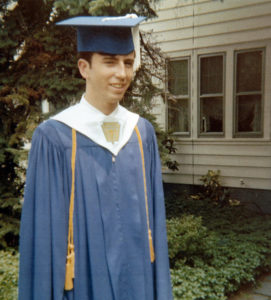
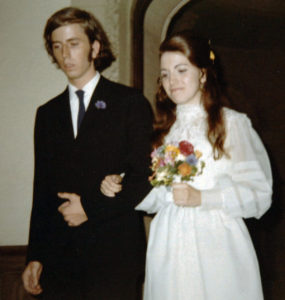

The idea was electrifying! Instead of a half-God figure walking down the street casually performing miracles with a flick of the wrist, how much more thrilling to picture a man – like me – using his own inner resources to create brilliant schemes which might achieve the same things as the seeming ‘miracles’. This was a man I could model myself on! Not the pederastic Father Imbroglio, not the financially-gifted Father Cash. Not even my own father, whom I would much later come to realize was a captive of his own era. And certainly not an uninspiring Man-God bent on making us all feel guilty and unworthy. I’d rather picture a schemer who schemed alone and then recruited others to pull off something that would rock the world he lived in. Yes!
Of course, I eventually had to ask myself, what would I have done in his place? When realizing that I might harbor such potential greatness, would I act on it? This was a question that strikes close to the heart of anyone in adolescence. Those are the years when our forebrain grows into final form, comes on-line so to speak, creating a feeling that we are destined for some greatness, but can’t quite put our fingers on what type. I decided that, in his place, I would do what Jesus had done. I’d hole up for years, reading the scriptures, making plans, and (most of all) developing a message worth spreading and the courage with which to spread it. And when you stop to think about it, isn’t that what countless great individuals have done?
For the first time in twelve years of Catholic schooling, Jesus was now my hero. Oh sure, he had long been my God and briefly – on retreat – had been my lover. But now he was a role model – Jesus as human, Jesus as a man become Man. After all, isn’t that how he always referred to himself in the Gospels – the Son of Man?
In the Catholic Mass of the 1960’s the congregation recited a long passage that was a declaration of our faith, in all its details. “I believe in God, the Father Almighty, Creator of Heaven and Earth. I believe in Jesus Christ, His only Son, our Lord, who sits at the right hand of the Father,” etc. As 1969 wore on, I found myself remaining silent during the parts, in which I no longer believed. After all, I did not come to church to lie! By summer I found myself staying silent through two thirds of this passage. I finally had to ask myself the Big Question. What was I doing here if I didn’t believe in it? My answer came not in words, but in action. That fall I went off to college, and I never went to Mass again.
Over subsequent decades people have occasionally urged me to attend midnight mass on Christmas “just for the singing of the carols” or on Easter “for old times’ sake”. But I have Father Imbroglio’s message firmly implanted in my brain. One year I had drawn altar boy duty with him at Christmas midnight mass. He’d kidded about his sermon before it started. “You know, Burke, I don’t have a clue what I’m gonna say when I get out there. But every year I never do. I’ll think of something when the time comes.” When the time came his sermon was a furious excoriation of all the ‘hypocrites’ he recognized out there. “You false Catholics, who don’t bother with Mass all year, but then come here to feel good this one night!” Even then, a true believer, I had turned beet red with anger and shame that I had to sit up there and be associated with this man spewing venom in the name of Jesus. But I have to admit that he was right, and I have silently thanked him many times since. Like Cortez reaching the New World, I burned my ships behind me when I left the Church. So, it’s no surprise that I haven’t been back.
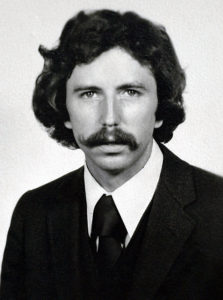
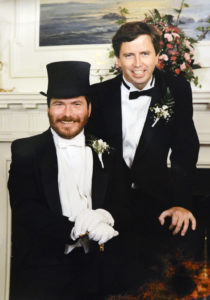
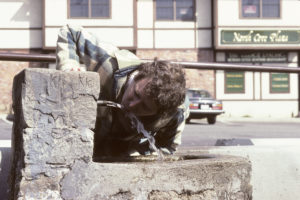
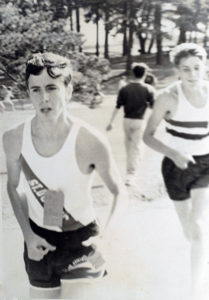
In eighth grade I had the opportunity to attend an exclusive high school for bright students in Manhattan. My father was a proud alumnus and as such had fought to get the school’s rules changed, so that non-city residents could attend, if they were sons of graduates. Despite this I told him that I didn’t want to go. The heavy homework load and long commute would leave no time for athletics. I told my father that I wanted to run. Though it must have hurt him, much to his credit, he never argued. Instead he came to nearly every race I ever ran.
While I may have been fast for my neighborhood, my speed couldn’t cut it in inter-school competition. So, I wound up a distance runner and am grateful that I did. Our coach was dead serious about getting the very best from us and pushing us to our limits, which meant training regimens so brutal that I started getting scared by one o’clock each day in anticipation of practice, and stayed nauseous for two hours afterwards. Yet that is exactly why I am glad I ran. In distance races I found what it truly meant to push myself, to find toughness I never dreamed I possessed. Since there is no one but you and your will on forested hills, I learned how to make myself go beyond what I thought I could tolerate. On long road runs, when I thought I was too tired to continue, I would ask myself if I was really incapable of going two telephone poles further. When I got there, I realized I had another two telephone poles worth in me, and rung by rung got miles out of myself that I didn’t know were there.
No matter what I have done since – all-night study sessions, 100-hour work weeks, hiking through snow off treacherous mountain passes with potentially fatal nightfall looming – I have persisted and comforted myself with one thought: I had put myself through worse on the hills of Van Cortlandt Park. If I could do that, I reasoned, I can do this – whatever ‘this’ might be. When faced with attempts at intimidation from self-described tough guys, I have been able to silently laugh, knowing that most of them weren’t man enough to do what I had done, alone, in workouts and competition. I have so far managed to live a life I consider rich and fulfilling, and I don’t think I would have done a lot of it, if it hadn’t been for the character that I built during endless, agonizing hours of long-distance running. It was worth every mile.
I spent over seven years sharing many experiences with John – always an adventure. One of our first museum trips into New York City led to John’s discussing Ice Age art, and the images of its goddess. I had never met anyone, who could discuss pre-historic and primitive art with such clarity, from a spiritual and academic perspective. I used these shapes and patterns in my jewelry designs, and John shared his theories about where they came from in our subconscious memory, passed from our ancient ancestors.
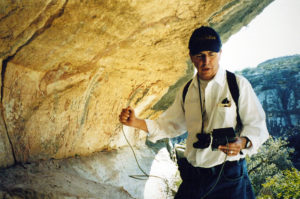
On our way back from Big Bend National Park, on the Texas-Mexico border, we spent a couple of days with the Rock Art Foundation – out of San Antonio. They were interested in John’s research, and invited us out to some distant sites on private land – a long bumpy ride on dirt roads in 4-wheel-drive vehicles. We were delighted to be in the midst of so many amazing and beautiful examples, created on long rock overhangs. John took many macnetic readings at the base of the rocks, as we discussed the spiritual meaning of the designs, all pre-historic, some thousands of years old. The Rock Art Foundation members were saddened by the crash of the space shuttle that day in 2003. One of their members, an astronaut, had carried the ‘white goddess’ statues up into space with her on this trip, both to become part of the cosmos.
Big Bend National Park was a very special place to visit. Quite a distance from anywhere in Texas – in fact many Texans have never been there. A sign informed that the border – the Rio Grande River – had been closed after 9-11, and a $ 5,000 fine would be given to anyone going over to the Mexican side. The Mexican villagers had survived by a few tourists going over there to eat in a café and buy their wood sculptures and walking sticks.
Well, the sign didn’t stop John. The way to get over to the Mexican side was to take a short swim across the Rio Grande. John just had to make that swim. Luckily, no border agents observed this, and we safely hiked back to our car, John pleased to have been to Mexico.
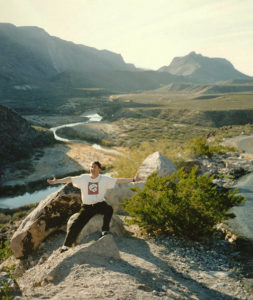
One particularly large mound was in Philadelphia, Mississippi, where three civil rights workers had been murdered in the early 1960’s. To us it didn’t appear that things had changed a whole lot, as people still drove around in pick-ups, with guns in view. We chose to keep our opinion to ourselves.
We spent some fun time in New Orleans, staying in the French Quarter, where I had lived in the 1970’s. Great music, architecture, food, old plantations, and ‘voodoo’ cemeteries. John participated in a trade show for seed companies from all over the world, which took place in a large hotel near Jackson Square. He reserved a suite to meet with prospective customers. As they ran out of regular suites, all they had left was the ‘presidential’ suite – which we got at the same price. The views from up high were magnificent, overlooking the Mississippi River and the whole French Quarter. The suite had beautiful antique furniture, and a private key to the floor. The guys from the seed companies were truly impressed, and John fit right in up there!
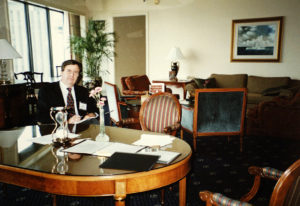
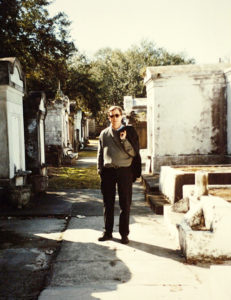
A number of trips took us to the west coast of Florida, where my father lived. Sanibel Island was very special – turquoise water, sandy beaches and great shells. Walking at night in Venice, along the Gulf, we came upon giant nesting sea turtles. John always said it would be great to spend the summer in Maine and the winter in Florida, swimming all year round!
Another special place for John was Holland, where he was working with seed companies. We traveled around by car, fascinated by the Dutch ingenuity in creating farmable land on areas, which were formerly covered by sea water. We stayed in a charming town in northern Holland, Enkhuizen, near the Zuider Zee, laced with canals and beautiful architecture, although on a small scale, compared to the wonderful city of Amsterdam, which we also enjoyed exploring.
In the Dutch countryside we enjoyed a tour of a restored windmill, as it would have looked in times past. A family would work and live there – all so efficiently. We were fortunate to be in Holland for the ‘Floriade’, which took place every ten years – a sort of ‘World Fair’ of flowers. We were mesmerized by endless fields of colorful tulips around the country, like a giant earth painting.

Another Californian site we enjoyed was Ojai – a spiritual spot made famous by the Indian teacher Krishnamurti. The Ojai Foundation asked John to do magnetic readings there. Other great Californian national parks were Sequoia with its magnificent ancient sequoia trees, and Death Valley with its gorgeous dunes and rock formations. Luckily, we were there in the fall, when temperatures were perfect.
My Aunt Suzanne lives in Pebble Beach, near the famous 17-mile-drive, a few miles from Carmel. She loved having John visit. We enjoyed our stays there, listening to the seals in the distance, dining on her delicious French food, and driving down to nearby Big Sur to explore the magnificent coast, down to San Simeon, William Hearst’s mansion, and redwood trees. It was the perfect spot for John – mountains and sea.
Another memorable drive was in February 2002, driving from Tucson, Arizona, to Albuquerque, New Mexico, to catch a flight back to N.Y. In the morning John looked at the map, and instead of taking the easiest and most direct route by interstate, he chose a scenic route northeast of Tucson, through the turquoise and copper mining area, beautiful forests, and a designated Arizona Wilderness. Signs informed us that if there was a snowstorm on this windy two-lane road, it would only be cleared on weekends – but this didn’t deter John. Luckily, we did not encounter any major snowfalls, just snowy patches.
We barely missed a large elk, which jumped in front of the car. The highlight of this drive was coming upon three released and collared, endangered Mexican gray wolves, walking on the side of the road. We stopped and just gazed in awe at these magnificent animals. At nearby Hannigan Meadows, high in the mountains, we learned more about the scientific studies of the wolves, and that mountain lions were often seen here, too. (We missed these.) The skies at night were as black as could be imagined, with no man-made lights, and the stars stupendous. Luckily, we reached Albuquerque, with still a bit of gas left.
John and I were fortunate to encounter wildlife often on our travels, a special treat for both of us. John’s spirituality was in tune with the natural world, truly a ‘religious’ experience for him.
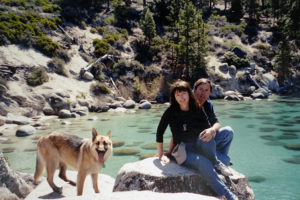
As the American Revolution was one of John’s favorite subjects, he actually wrote a wonderful historical novel, Rose of the Revolution, based on the Culper Spy Ring, on the North Shore of Long Island. Robert Townsend, from Oyster Bay (John’s hometown), was a member of this ring, and others lived around Setauket, a few miles from my home. We wandered through many old cemeteries on Eastern Long Island, looking for the possible identity of a woman spy, who supposedly died on board a British prison ship in N.Y. Harbor, and was from a prominent Long Island family. She may have had a relationship with Robert Townsend.
John was determined to solve this mystery, but it still remains an unknown piece of American history. Hopefully, one day the novel will be published, and someone will discover the truth about ‘Elizabeth’ – the name John gave her in his book. As John was so fascinated with the American Revolution, perhaps in a past life he was a part of it!
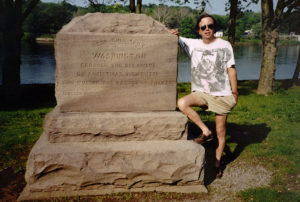
John was truly a ‘Renaissance Man’ and will be well remembered by all who knew him. His time on Earth was not as long as we would have hoped for, but in his 58 years he lived a life of ten lifetimes, so rich and full. John was a true explorer, and is now part of the cosmos.
John saw himself as a mystic, living life to the full, spiritually, physically, and intellectually. Stretching his borders, his life was an exploration, and those of us who knew him are fortunate to have shared his vision.
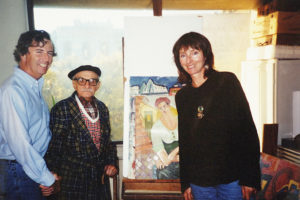
When I entered the office, there was this strange American walking around and asking everybody: “Would you like to trek with me to Everest Base Camp?” Here I was, a timid young man from little flat Denmark, who had never been trekking in Nepal before. I told him that maybe the Everest trek would be a little too hard for me. I delivered my application for a trekking permit to a less demanding area and started walking away from the office. However, I had only walked about a hundred yards, before I thought: “Hmm, he did sound quite interesting – maybe I should join him anyway.” And I have never had any reason whatsoever to regret that decision ever since. I went back to the office, where John was still searching for a companion, and told him about my change of plans. “Great”, he said.
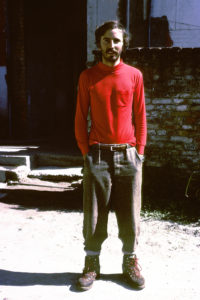
We flew in a small plane to the airstrip at Lukla. The landing on the short runway was quite an experience, as the plane jumped like a kangaroo – we later learned that one of the engines had failed during landing. We got our luggage, and off we went behind the Austrians – at full speed. Trying to keep up with these formidable women was quite a challenge, and after a few days, John and I began to feel uncomfortable, dizzy and nauseous – sure signs of altitude sickness. We decided to split from the Austrians and walk at our own pace – I think they were just as relieved as we were, to get rid of beginners like us.

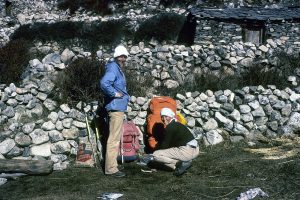
When we returned to Lukla to catch our flight back to Kathmandu, John felt that he needed to socialize over a beer or two, so he went to a restaurant that was popular among trekkers. I volunteered to wait at the camp ground – a grassy field near the village – to guard our luggage, until John would return in time for us to put up his tent, which we were sharing. I waited and waited – no John. Dusk, and still no John. I decided to put up the tent alone. However, besides being a camp ground, the field had an additional function, namely as a toilet, judging from the numerous piles lying here and there. So putting up our tent here, in the dwindling light, was a painful task – finding a space large enough, without those piles, was not easy. But I succeeded and crept into my sleeping bag.
Later, when it was already pitch dark, John finally returned. Sticking his head into the tent, he said: “Thanks for putting up the tent.”
I told him about my difficulties, to which he commented: “I wouldn’t even have been able to do that myself!”
I urged him to examine the soles of his boots very carefully before entering the tent.
Our hike in Sagarmatha National Park is related in detail on the page Travel episodes – India & Nepal 1978: Journey towards Everest.
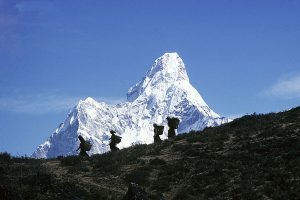
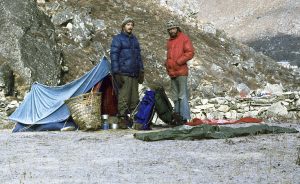
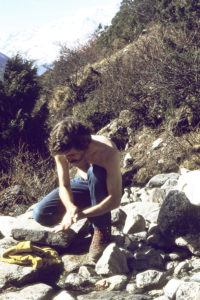
In the beginning, John thought that a trip to a wildlife sanctuary meant something like a safari in Africa. But, being John, he decided to do some library research on it. To his great delight, his research revealed that this sanctuary was a little-visited mountain area, mostly explored by climbing expeditions. We planned the trip, and in October 1982 we all met in Delhi.
We stayed a few days in Lata, where we hired a number of porters and bought more provisions. From here, a long and very steep trail went up through forest of pine and cedar to a ridge called Lata Kharak. John walked some distance behind Ajai and me, and he later told me about a strange encounter, he had on the trail. As he was struggling along with his heavy backpack, he saw one of our porters, an elderly man, lying beside the trail, utterly exhausted. When he saw the white sahib, he opened his mouth, pointed down his throat and said: “Vitamin E!! Vitamin E!!”

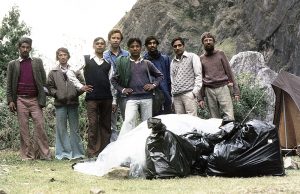
Ajai, who was a student and not so fit, began to get tired and lagged behind. He sat down on a rock, so we went back to see, what was the matter. He refused to move and said: “Just leave me here. I’ll spend the night here, I can’t go on.”
“Don’t be ridiculous,” we told him, “if you stay here, you’ll freeze to death.”
“Oh no, I can’t go on”, he insisted.
A snow storm was looming on the horizon, so we decided that I would walk in front of Ajai, while John walked behind him, pushing him forward, every time he tended to slow down. To do this, John had to abuse him, calling him nasty names, which made Ajai angry, and the produced adrenalin somehow made him able to continue. Darkness was falling, and we still had to negotiate down a steep slope.
In the very last light of the day we struggled into our camp near a big rock, under which our porters had decided to spend the night. We got company from an Indian climbing expedition, and one of the climbers was this gorgeous girl from Calcutta. Ajai immediately forgot his tiredness and babbled away with the girl for an hour or more. That night we slept like logs. Next morning there were fresh leopard tracks outside the camp.
We had thought that we would make it into a circular valley called ‘The Sanctuary’, surrounded on all sides by tall mountains. But we got wiser. Two members of an expedition that had just climbed a spectacular white granite mountain named Changabang, informed us that to enter ‘The Sanctuary’ we would have to deal with “treacherous snow on treacherous ice on treacherous rock”, as they expressed themselves. This scared us off, but we made it to a great glacier named Bethartoli, where we camped for several days.
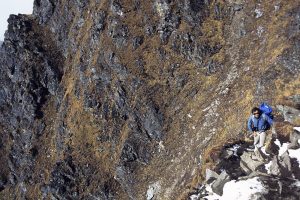

I felt an almost irresistible urge to hit him!
We returned by another route out of the area, along the Rishi Ganga River. In this way, we wouldn’t have to cross the awful Dharansi Pass, but otherwise the trek was far from easy. We had to dangle on ropes down sheer rock walls, and cross the Rishi Ganga by balancing on rather thin logs. Gabar Singh, in his black shiny ballroom shoes, just danced over these logs like nothing, but we were scared stiff while crossing. John even stopped halfway across a particularly nasty log, holding on to another log with both hands. Gabar Singh had to go out and help both of us across.
Finally, we entered agricultural areas. Gabar Singh pointed to a harvested field and said that this was a good place to camp. John went out to have a look, but quickly returned and said: “Holy shit, we are going to camp in a marihuana field!”
When we reached Gabar Singh’s village, John gave him his sneakers, so that he would not have to wear his black ballroom shoes on future hikes. Later that day we met him in the street, clad in his best finery: Super-clean clothes and John’s sneakers.
Our hike in the Nanda Devi Sanctuary is described in depth on the page Travel episodes – India 1982: Pleasures of Nanda Devi.
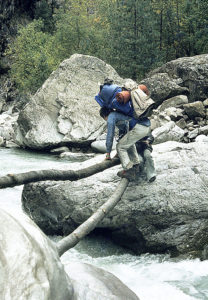
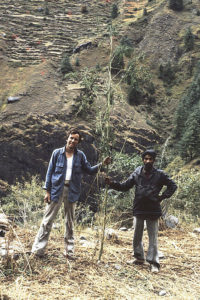
In October 1999, we met in South Dakota. This was during the period, where John had a great interest in measuring telluric ground currents and airborne electric charge at ancient structures and sacred sites in North America and Europe. It was his theory that they were not only constructed for religious purposes, but that their main purpose was to improve the yield of crops. The results would later be included in our book Seed of Knowledge, Stone of Plenty. (This book may be read in full elsewhere on this website).
We undertook a hike to the top of Bear Butte, a mountain which is sacred to the Lakota Sioux. Along the trail, a local shaman had marked certain spots with bits of brightly colored cloth. John got interested in these spots, and on each of them he measured the airborne electric charge. Sure enough, the shaman had marked all the powerful electric spots on the entire mountain.
Later, we went up Black Elk Peak (formerly Harney Peak) in the Black Hills, the most sacred mountain of the Lakota. This was rather tiring, so at some point we took a break. John lay down and closed his eyes, resting his head on a rock. Immediately he felt dizzy and disorientated, so he got up to investigate. Through the rock ran a vein of quartz, a mineral that is highly conductive of electric ground current. John got out his instruments and started measuring. Typical for John – he wanted to rest, but ended up doing scientific work.
We drove in two cars, because John was going to meet somebody in the seed business. One evening, at dusk, we were driving south on a completely straight highway. There were only a few clouds in the sky, no wind at all, and on our left, a huge, gorgeous Full Moon was rising. When we arrived at our hotel, John and I got out of our cars, looked at each other, and just smiled.
John then said: “I felt I just had to listen to Beethoven, while that Full Moon was rising! The harmony was perfect!”
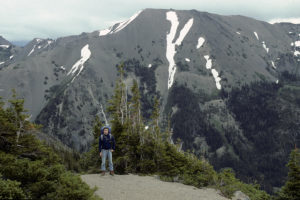
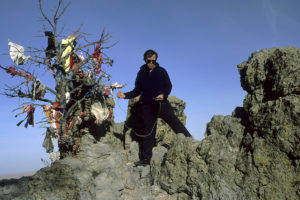
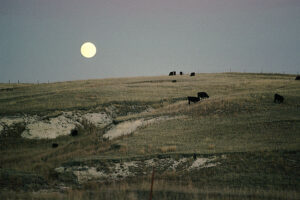
In Wiltshire, we carried out a number of measurements of telluric ground current and airborne electric charge at some of the ancient sites. One was Silbury Hill. Erected c. 2700 B.C., this man-made mound is 130 feet high and covers 5.5 acres. It consists of consecutive layers of – from the bottom up – gravel, sod, soil, clay, chalk, and gravel. Around the mound a ditch was dug, part of it through the surrounding chalk hillside. This ditch was more than 400 feet long, 20 feet deep and 70 feet wide at the top. But, most importantly, two sections were left intact, forming solid land bridges over the ditch from the hillside to the mound, thus creating what is called a causewayed enclosure. Drainage of rain water through the porous chalk would produce a powerful electric charge, and the telluric ground currents would choose the way of least resistance – through the causeways. Our measurements of electrical ground charge at different spots on Silbury Hill showed this beyond doubt, as seen from the table below.
Later that year, John again went to England to measure energies at various places, including Avebury Henge. Not everything was taking readings, as you can tell from this quote from Seed of Knowledge, Stone of Plenty, p. 129: “On a hot August day in 1993, while bending down to take a reading, I suddenly heard an unidentifiable noise right behind me. Turning around, I saw a sheep happily munching my notes. A good hundred visitors to the henge that day were treated to the spectacle of a seemingly deranged man, shouting and sprinting after a harmless sheep – all the way across the circle. Luckily the records, though crumbled and smeared in saliva, were still readable.”
John’s work, together with that of W.C. Levengood, lead to the invention of a machine that would give seeds a ‘shock’ through pulsing DC electricity, following the principles of the method of the ancient farmers. This modern method they called Molecular Impulse Response, shortened MIR.
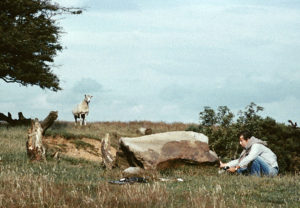
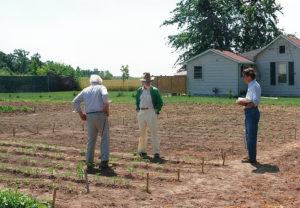
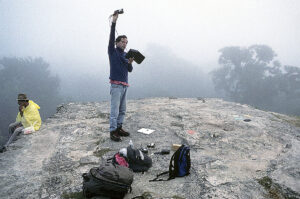
– – –

At this early stage of investigation, Levengood pursued various experimental evaluations, some of which were non-productive, others of which began to form the basis of a consistent description of characteristic changes in crop circle plants. He had begun to document abnormal enlargement of the growth nodes in the circle plant stems, and seed-germination studies were revealing clear alterations in the normal development of the seedling embryos, indicating interference in the reproductive capacity of the circle plants. It was obvious that something unusual was affecting these crop circle plants – the question, of course, was what?
By 1992, John Burke, a New York businessman with a strong avocational interest in geomagnetic and electromagnetic theory, and Nancy Talbott, a music producer with a research background at the University of Maryland and at Harvard College, had both become interested in the crop circle phenomenon and had contacted Levengood about his crop circle research. Excited by the early laboratory results and Levengood’s conviction that something highly unusual was taking place in the crop fields, Burke and Talbott were interested in assisting the research effort and an informal collaboration – the ‘BLT’ (Burke, Levengood, Talbott) Research Team began to take shape.
By now crop formations were being reported in countries around the world, and it was apparent that an organized international reporting and field-sampling network was needed. Talbott set about creating these networks in order to obtain samples from newly-discovered formations; she developed a concise field-sampling protocol, located and trained new sampling personnel, arranged for the shipping of plants and soils to Levengood’s Michigan lab, and financed the attendant expenses.
Burke worked on the theoretical ideas emerging from Levengood’s laboratory data, spending considerable time in NYC libraries researching the scientific literature. Together Burke and Talbott carried out various field experiments in the U.K., and networked with other researchers so as to stay informed of any new developments in the phenomenon.
Over the next eight years, a significant number of crop formations (approx. 300) were sampled in seven countries – the U.S., Canada, England, the Netherlands, Germany, Australia, and Israel. Field-trips to sample circles and gather on-site data in the U.K., Germany, Canada, The Netherlands, and the U.S. were undertaken by Ms. Talbott each summer, and dozens of other crop circles were documented and sampled by the growing number of new field-workers. Control studies were designed and carried out, and thousands of hours of field, office, library and laboratory work were expended. Laboratory reports on individual cases were written up and mailed out to land-owners and farmers around the world, as well as to the fieldworkers involved in each event and to local media.
In 1993, a crop formation at Cherhill, England which had occurred during the annual Perseids meteor shower, had been found with a glaze of very pure iron covering – and embedded in – some of the downed plants. Following this discovery, regular soil sampling was instituted and carried out on most crop circles studied subsequently.
The results of this early work were clear and thought-provoking: There are pervasive, re-occurring abnormalities in crop circle plants and soils (as compared to the control plants and soils taken from the same fields and as compared with plants evaluated in the control studies) which are consistent with exposure of these plants and soils to an intense and complex energy system, which emits heat (possibly microwaves) along with highly unusual electrical pulses and strong magnetic fields. Of the c. 300 crop formations sampled by the BLT Team and examined by Levengood from 1990 through 2000, more than 90% showed the characteristic anomalous changes in somatic (non-reproductive) and/or reproductive plant tissues, and magnetic material was consistently documented in those formations, where soil sampling had also been conducted.
Three research papers were written during this 10-year period and published in peer-reviewed scientific journals, establishing in the scientific literature for the first time that the ‘human pranksters with planks and boards’-theory of crop circle causation was inadequate – and that something much more intriguing is going on.
The BLT Team has never been able, financially or logistically, to sample every formation reported in every country around the world each summer and, therefore, cannot extrapolate precise figures regarding this ‘man-made/real’ debate. Our work is, however, the most comprehensive to-date, our choice of formations to be studied purposely random within each country, and we have utilized hundreds of different fieldworkers, a majority of whom were totally unacquainted with each other and often equally unaware of lab results previously obtained. These facts strongly argue against bias on the part of the field-teams, as does the fact that more than 90% of the formations evaluated in the lab – regardless of country or field-personnel involved – reveal the same plant/soil abnormalities we now associate with the real phenomenon. The fact that the various testing procedures have shown high correlation with each other helps rule out experimenter-bias, and the control studies have clearly established the fact that manually-downed crop (using planks and boards, human feet, and a cement roller) does not exhibit the physical changes observed in crop circle plants over the years. It seems probable, then, that the overall number of man-made crop circles is relatively small, compared to the total number of circles discovered and reported each year.
It should also be emphasized that our contact with landowners and farmers indicates that many crop circles go unreported each year, either because they occur in very remote areas and are never discovered at all (crop circles occur in all kinds of plants, not just cereal crops) or they are found at harvest by farmers, who are either uninterested in reporting them or unaware of the reporting network. Furthermore farmers, whose land has been farmed by generations of the same family, regularly report that previous generations did occasionally report the discovery of crop circles while harvesting.
In 1999, an opportunity to carry out some new research presented itself, when New York philanthropist Laurance S. Rockefeller offered funding. In order to meet Mr. Rockefeller’s requirements, Ms. Talbott sought and was granted non-profit, tax-exempt status, and BLT Research Team Inc. was created, with Ms. Talbott as President. For several years Ms. Talbott had been encouraging the interest of several scientists, with differing expertise, in the crop circle situation, and it was through one of these – Utah geologist Diane Conrad – that a new investigatory approach to the phenomena was instituted. In 1996 Ms. Conrad, then a resident in Utah, had carried out X-ray diffraction analysis on soil samples retrieved from a crop circle in Providence, Utah. Her very preliminary examination seemed to indicate that an in-depth XRD evaluation of crop circle soils might be productive, and this project was subsequently carried out with the Rockefeller funding. A scientific paper by Dr. Reynolds and Ms. Talbott, to be published in Nature, was in progress, when Dr. Reynolds died. The result of this was that the paper was never published. However, the entire study can be seen on this website: bltresearch.com/xrd.php.
Slowly, as new scientists learn of the research results obtained so far and begin to recognize some of the implications, the BLT Research Team Inc. is adding to its list of consultants. Although the media has made this progress more difficult by labeling the crop circle phenomenon as ‘fringe,’ hard data – obtained through rigorous scientific methodology – is difficult to ignore. As one prominent consultant recently replied, when asked if he was concerned about possible skepticism from his peers, “the data is the data.” And following such data, wherever it leads will most likely lead us, eventually, to an understanding of this most enigmatic, peculiar phenomenon.
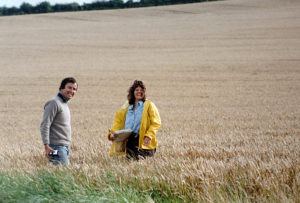

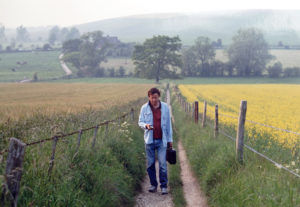

Ten years of laboratory investigation by W.C. (‘Lefty’) Levengood has definitively determined that crop circles are events, which begin in the atmosphere with swirling, self-organized masses of electrified air ions, called plasma. When these impact a field with, for example, wheat in it, they create a number of known effects.
1) Microwaves (always produced when plasma swirls in the geomagnetic field of the Earth) heat crop and stretch wheat nodes from the inside, creating expansion which often varies precisely with the distance from the center of the circle. (This is the same principle which requires you to puncture a potato with a fork before microwaving it in your home oven).
2) Another effect of the plasma is to leave the downed wheat (and sometimes the standing edge) electrically charged. This has been repeatedly confirmed with standard scientific electrostatic voltmeters by myself and Simeon Hine, who works with Ron Russell of Colorado. Prior to us, Paul Vigay had been getting the same results on a homemade meter.
3) The presence of a magnetic field in the swirling plasma has been evidenced by the clustering patterns of iron particles of meteoric dust. These various findings have been published by us in a series of papers in peer-reviewed scientific journals.
The work of BLT and others showed that the energies which produce crop formations come from very high up in the atmosphere, probably 40 miles or more up to the ionosphere, which is nearly all plasma, or heavily ionized/electrically charged air. Why would these plasmas be attracted to carbonaceous aquifers? Checking the scientific literature, we found there was a very good reason. Water percolating through porous chalk or limestone, electrically charges the rock (by means of adsorption, and ionization during dissolution, for the technically-minded reader). Checking United Nations surveys, we found that the English aquifer has the highest seasonal water movements of any major aquifer in the world (30-100 ft.). This means that as the summer wears on, sinking water levels cause the water to drain through and electrically charge the rock. Because it is softer and more porous, chalk charges better than limestone and – what do you know – gets many more crop formations above it than its limestone cousin. Southern England has more water charging the ground this way, closer to the surface, than anywhere else in the world. And it seems (in my opinion) to get more crop formations than anywhere else in the world.
As we know, electric charge attracts objects of opposite electric charge, so electrically-charged earth can attract electrically-charged air. There is a magnetic component as well. Regions of differing electric charge (like negatively charged surface chalk and positively charged water deep within it) create electric currents between them, of DC voltage. Like any currents, these produce magnetic fields. These magnetic anomalies could act as attractors of crop formations as well. BLT has measured these electric ground currents and magnetic anomalies on site in England and linked them in one instance to the occurrence of a sixty foot dumbbell formation, and in another case to the percolating water from a heavy rainstorm.
In North America, we do not have any significant chalk aquifer, but we have huge, extensive limestone aquifers. And we have crop formations, but not nearly at the density per square mile as in southern England. Where formations occur in North America tends to be over areas with limestone layers beneath, usually known aquifers. Where river valleys have cut into that aquifer, leaving an edge at or near the surface, appears to be a particularly attractive site. Crop formations have occurred in the East and Midwest as far north as Canada, but not (so far as I know) on ground underlain by the metamorphic rock of the Canadian Shield. Instead they occur on ground, which was once part of ancient inland seas and have limestone beneath the surface. The maps I have consulted show no formations over the geological layers of the Rocky Mountain Cordillera. They appear right up to its eastern edge in places like Kennewick, Washington and again in the limestone-floored aquifers of the west coast between the Rocky Mountain Cordillera and the Coastal Range. This includes Burlington, Aona, and Chehallis in Washington and Gaston, Salem, Lebanon, and Klamath Falls in Oregon (in addition to others).
Now, what about those megaliths? Brian Grist found that the most intensive crop formation activity seemed to be on interfluves. These are boundaries between two adjacent layers of aquifer, where they have angled to the surface. It is known that different layers of aquifers usually differ in their ability to conduct electric ground current (i.e. differ in their conductivity). It is also known that the normal, gentle fluctuations of the earth’s magnetic field are multiplied several-fold at such conductivity discontinuities. And whenever magnetic fields fluctuate, they generate electric ground current as well. We have used fluxgate magnetometers, electrostatic voltmeters, and professional ground electrode systems to measure the presence of these energies at such spots.
The archaeological literature states that causewayed enclosures such as Windmill Hill were built all over Europe from roughly 4000 B.C. to 2800 B.C., but virtually always on interfluves (and their conductivity discontinuities). These evolved into the henges. Both feature a ditch cut through the surface (which will block the flow of the kinds of natural ground currents discussed here). Both feature openings of unbroken ground left in the ditch, through which all the ground current would be forced to flow, like water seeking out the path of least resistance. This can be seen in a 1998 soil resistivity survey of Stonehenge by British scientists. This concentration of natural geomagnetic and electric fluctuations is a defining characteristic at virtually all megalithic structures. These ancient ‘monuments’, be they mounds, henges, pyramids, or dolmens, were placed by their builders on spots which had a high concentration of these natural energies, and then they designed and built the structures in a way so as to further concentrate the energies.
Similar ‘rules’ of placement can sometimes be seen at large Native American rock art sites. While we have not investigated these in nearly the depth of the megalithic monuments, there are places like Petroglyph National Park which, on the west bank of the northern Rio Grande in New Mexico, runs for miles along one of the biggest conductivity discontinuities in North America. Perhaps tellingly, the 100-yard Creation Story panel which is arguably the most important, has its central figure (a maize stalk) created right over a vertical scar in the rock, created by a lightning strike. The magnetic anomaly created by the lightning is strong enough to deviate compass needles.
How did such pre-scientific peoples detect these energies and to what purpose? The differences in magnetic strength present at the sites we have surveyed are far larger than differences which can be detected by individual humans, studies show. Magnetic fluctuations of only 50 nano-Teslas are detectable by even average people under certain circumstances, and the fluctuations we find at ancient sites are several times larger than that. Finally, a few individuals have been shown in carefully controlled scientific studies to be able to consciously and consistently detect much tinier differences. Andrei Apostol has taken one such individual blindfolded to Native American mound sites, and the individual’s muscle contractions have always perfectly coincided with him entering the sites, which are placed on magnetic or gravity anomalies.
Enough for the how, what about the why? At least in the case of rock art sites, we can hazard a guess. It is now the consensus opinion of rock art authorities, that most of it was created by shamans while they were in altered states of consciousness, with the rock art itself reflecting the hallucinations of the artist/shaman. While in southern United States there may have been access to peyote (which only grows naturally in Mexico), the northern U.S. has a serious paucity of natural hallucinogenic substances. Natural fluctuations of electromagnetic energy may have helped fill this gap. Michael Persinger of Laurentian University in Ontario has conclusively demonstrated the extremely altered states of consciousness, which can be produced in average people given magnetic fluctuations of a level often found in Nature. We ourselves have found such magnetic anomalies at Native American vision quest sites, which are still used and where participants report hallucinatory episodes of frightening strength at the same time of the day as the greatest electromagnetic fluctuations.
There is no real mystery in any of this, once you think about it; neither is there any need to invoke ‘non-physical energies.’ (*See quote by Arthur C. Clarke below.) The magnetic field fluctuations not only create electric currents in the earth (by a process known as induction), but they create electric currents in any material that is capable of conducting electricity. The human brain is, of course, a superb conductor of electricity, and so these fluctuations induce natural DC electric currents in our DC (Direct Current, unlike household Alternating Current) electrical brain. No surprise then, that it produces powerful mental effects.
We do not mean to say that the induction of visions was the primary purpose in building huge megalithic sites such as Stonehenge or pyramids. The purpose there is another discussion altogether, to be held at another time.** But rock art sites and vision quest sites may have been placed, where brains would be powerfully affected by the same energies which attract crop formations.
For those of us who live in the twenty-first century, it is good to remember that these fluctuations occur at some level everywhere, mostly two hours or so before dawn. Studies have shown that people lying flat on their back with head toward the east while a modest laboratory fluctuation takes place, report experiences of blissful reverie. Those with head pointed north report fear and anxiety, while west and south produce no noticeable effects. Like it or not, we are all involved in an electromagnetic dance with our home planet, every single day. So, while the mystery may be solved, the magic and wonder of the dance is something we take joy in for as long as we may live.
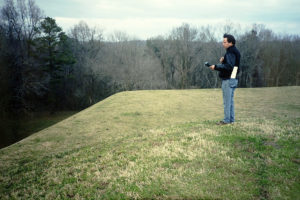
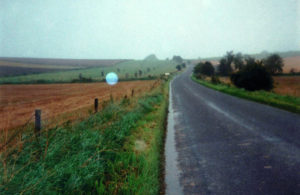
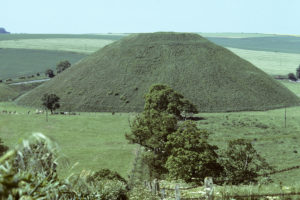
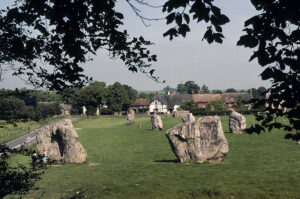
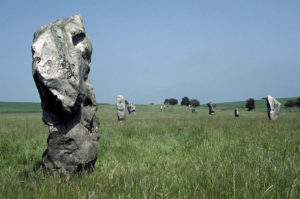
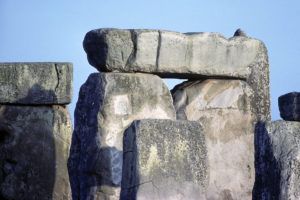
Modern ecological science concentrates on the importance to life of water, nutrients, and temperature – all key ingredients to the chemistry of life. However, the mechanisms of life are electrical as well as chemical. Our nervous systems constitute our own internal ‘wiring’. This wiring is affected by electromagnetic changes on the environment. In fact, our consciousness can be radically altered by such changes.
Dr. Michael Persinger – Professor of Psychology, Laurentian University, Sudbury, Ontario – has repeatedly demonstrated that magnetic fluctuations, of a magnitude consistent with natural geomagnetic fluctuations, can stimulate the most profound changes in the human psyche. When modern college student volunteers wore a computer-controlled, wired helmet and had their brains subjected to slowly fluctuating magnetic fields of 50 gammas strength, they frequently reported religious experiences. Chemical mind-altering substances have been accepted as legitimate religious aids in numerous Native American religions. Might natural, electromagnetic aids have been used as well?
Persinger’s work follows on the heels of another Canadian, Wilder Penfield, who discovered that when the brain was exposed during surgery, he could insert electrical wires into the cortex and produce a wide range of reported, internal experiences in the patients simply by running small currents through the wires. Fluctuating magnetic fields produce electrical current in any conductive tissue, including brain tissue. Reasonably powerful magnetic fluctuations can and do produce electric currents in the brain. We should expect that these currents would produce a wide range of internal experiences. In fact, a new field of neuropsychiatry today is using this technique to explore the emotions of their patients.
Temporal lobe epilepsy has been associated with religious experience for so long, even in European culture, that it has been dubbed ‘the sacred disease’. Persinger and his associates find that set and setting have a great deal to do with which types of experience result. Playing Gregorian chants in the background, they found, tend more frequently to result in religious experiences among their subjects. All forms of epilepsy involve surges of electricity through the neurons of the brain. Temporal lobe epileptics tend to be people who report an extremely deep personal religious life. Persinger finds that subjecting the temporal lobes to EM fluctuations often produces religious experience. The more someone’s temporal lobes have been electrically stimulated, the more sensitive they become to electrical stimulation, and the less it takes to produce a catharsis.
It would seem that these mechanisms may well have been utilized by Native Americans who combined their knowledge of the land and their sensitivity to it, with the universal need for religious experience. Evidence for this can be found in the geology of so-called ancient sacred sites, as well as in practices still in use today at ‘places of power’, where the geology produces electromagnetic changes of the type and strength that Persinger has shown to be so effective in altering consciousness and producing a religious experience.
Apparently Native Americans, most likely shamans, repeatedly sought out electromagnetic anomalies to create special structures, such as mounds in the Midwest, and distinctive rock chambers or dolmens in the Northeastern U.S. Elsewhere rock art seems often to be concentrated at spots with unusual electromagnetic properties. This is in keeping with the theories of Lewis-Williams and others that rock art is produced by shamans in trance, actually illustrating their hallucinations in many cases. This hypothesis is backed up by the preponderance of the phosphenes, or form constants, that dominate so much of rock art as well as the hallucinations of all humans throughout all of history. Unlike so much of Native American lore, this field of study does not need to be broken down by tribe. The experiences in question here are even more ubiquitous than the vision quest – a cultural institution that cuts across tribal distinctions.
The Earth’s geomagnetic field fluctuates in strength on a daily basis, rising in strength during the day and dropping during the night. This is because Earth’s magnetic field lines are stretched into an elongated teardrop shape by their interaction with the solar wind. On the sunward side of our planet, the magnetic field lines are compressed by the solar wind, and this makes them stronger at any spot on the planet facing the sun. On the side of the Earth facing away from the sun, the magnetic field lines are greatly lengthened, as they are dragged ‘downwind’ by the solar wind. This stretching makes the field lines weaker. At sunrise, as our part of the planet turns from the dark into the light, the magnetic field lines shorten, and the strength of the geomagnetic field lines rises, sometimes fairly abruptly. This fluctuation in the strength of the magnetic field at our location does what all fluctuating magnetic fields do: It produces electric current in anything present that will conduct electricity. This is the principle of induction, which is one of the cornerstones of physics.
The induction around dawn creates electrical currents in the earth, called telluric currents. They travel close to the surface, mostly in the top meter or two of ground. Their strength will vary, depending on the ability of the ground to conduct electricity, which is called its conductivity. Ground with high mineral content will usually have stronger currents. These currents have two effects. First, they do what all electrical currents do and that is to generate a magnetic field. In fact, tracing the changes in the magnetic field is often the easiest way to follow these currents in practice, though specialized ground electrodes are the best method to directly measure the telluric current. They also attract airborne electrically charged particles, or ions, of opposite charge. Both have an effect on human consciousness. Persinger has charted the magnetic effect, and A.P. Krueger and fellow scientists on both sides of the former Iron Curtain have charted the effects of breathing air ions.
Obviously, the human brain is an extremely good conductor of electrical current. Induction will also create currents in our brains, with surges in the few hours leading up to dawn and perhaps the first hour or so afterwards. This is no doubt part of the effect studied by Persinger. Therefore, it is fascinating to note how often the creators of rock art chose to work where these forces were strongest.
Certain geological features can exaggerate the dawn fluctuations in electromagnetism. Electricity, like water, always seeks the path of least resistance. If it is flowing horizontally along the surface of the ground in a highly conductive layer of earth, and that layer then takes a dip deeper underground, for example, the telluric current will want to follow that layer and take something of a vertical dive. When that happens, the magnetic field being created by the current will change its orientation to the geomagnetic field lines at that spot and tend to either reinforce or weaken them. Telluric currents do prefer to travel near the surface however, and wherever a region of highly conductive ground meets a layer of less conductive ground on the surface, it is called a conductivity discontinuity by geologists. It has long been known that at such discontinuities the normal electromagnetic dawn effects are generally exaggerated and stronger. The dawn rise of the magnetic field, and the electric currents it produces in ground and brain, will be strongest at a conductivity discontinuity.
The largest collection of rock art in the U.S. is located in Petroglyph National Park outside Albuquerque, New Mexico. This is also the location of the largest conductivity discontinuity in the U.S. In fact, the rock art is carved right into the edge of the highly conductive basalt layer which ends there at the west bank of the Rio Grande floodplain. Even during the relatively homogeneous period of midday I have measured extreme fluctuations in concentrations of airborne ions and electric charge in the basalt layer. In fact, I was able to follow for miles a sudden surge in charge greater than I have measured in most thunderstorms. The electrostatic voltmeter actually went off scale even at the high scale setting. This has happened to me only twice before in years of study. Once was atop one of the oldest burial mounds in Britain, located atop a chalk (carbonaceous) ridge which is a conductivity discontinuity. The other time was at a particular spot at the Ojai Foundation in California, a point of a ridge over a powerful discontinuity at the San Andreas Fault. Tibetan monks and others experienced in meditation have said that this is the power spot, something they call ’The Dragon’s Eye’.
A 100-yard-long panel of art at Petroglyph Park is said by at least one Hopi elder to tell the story of creation. The central figure of the panel is a maize plant. It is placed directly over a visible vertical stripe on the rock, where a lightning strike had magnetized the rock so strongly that it deflects compass needles.
Limestone (carbonaceous rock) is very homogeneous and a poor conductor of electricity. How well it conducts is proportional to its mineral content. Water seeping into limestone creates electric charge and currents by two other physical processes, adsorption and dissolution. Adsorption is a process whereby electrons are stripped off the water droplets, as they squeeze through the small pores of the rock. The other, more powerful effect is the chemical process, whereby rainwater picks up carbon dioxide as it falls and encounters the chalk as a weak carbonic acid that dissolves the limestone, taking a positively charged calcium ion away as it sinks, leaving negatively charged electrons behind. In some places in carbonaceous rock, these currents and the local magnetic fields they create are measurable. Like telluric currents they follow the path of least resistance and react in a similar fashion at conductivity discontinuities.
In the Pecos canyons, in Texas, the cliffs create a conductivity discontinuity, and the seasonal water would create electric charge. Obviously any thunderstorms would do even more dramatically. Any further discontinuities would be the strongest site of these kinds of variations. I detected slight but real differences in magnetic field strength at all three rock shelters I visited to view rock art in the Pecos area. These were doubtless due to iron content of the rock at those spots. It must be stressed that it has been shown by controlled studies at the University of Munich that at least 2% of the population can reliably sense magnetic differences even smaller than my fluxgate magnetometer can reliably detect. Field magnetometers that are as sensitive as these people are extremely expensive.
What I detected at the three Pecos sites was:
The top of Bear Butte is flat, but only about 10 yards wide by 100 yards long. I found five magnetic anomalies up there, four of which had been marked by a ring of stones around the spot. The strongest one had a sleeping bag stashed in a nearby tree and was marked very differently with a complex set of colored flags marking out four corners, with strings of knotted cloth connecting them, while mini flag poles and Y-shaped vertical sticks held a horizontal stick. The poles and sticks were willow, which does not grow on top of the butte. My companion Kaj Halberg and I photographed and carefully recorded all this, and two days later, in a book store at the Crazy Horse Monument, we found a book, in which it was described how a Sioux man had asked for and received a one-night vision quest. He was lead to a similar butte and placed on a spot, surrounded by exactly all the identically colored flags at each compass point, the strings, willow sticks and poles, carried onto the butte by the shaman. He reported extremely dramatic visions in the hours around dawn (when telluric currents there would have been strongest), and came down cured forever of alcoholism, which was his purpose in requesting the vision quest.
The book went on to explain that this was a school of vision quest begun by a childhood friend of Crazy Horse, who took Crazy Horse throughout his life on vision quests. Since then we have learned that he actually took Crazy Horse to Bear Butte, where he would go up and have his experience, then come down and preach to his people about his visions in a meadow that is still there. Today, the South Dakota State Park Service still maintains this site on a limited use basis for whites. Visitors are instructed to never leave the trails and to never come to the park at night, when Native Americans use the butte for religious ceremonies.
The one time I actually felt these energies was while resting after lunch most of the way up Harney Peak (the tallest of the Black Hills and a longtime sacred site to the Sioux). As I closed my eyes and leaned my head back against a cliff face, I felt like my head was spinning. Whenever I took my head out of contact with the rock the feeling stopped, but whenever I laid it back against the rock it resumed. Standing up I saw that my head had been lying against a quartz vein. My electrostatic voltmeter confirmed that there was substantial electric charge in the vein. Surveying the rock face, I then found that the electric current was not measurable in the rock surrounding the quartz vein, but that it was present in other vertical veins of quartz in the cliff face.
A substantial body of evidence bolsters the argument that ancient peoples have long sited ‘sacred’ structures on conductivity discontinuities, and then designed and built structures that further concentrated the natural electromagnetic energies. I have thus far gathered data at only a few rock art sites, but findings so far are consistent with the aforementioned model. It will take more work at more rock art sites to confirm or refute a connection between mind-altering natural forces and rock art.
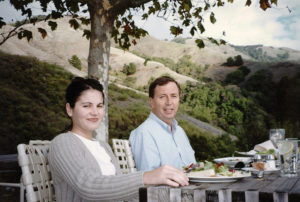
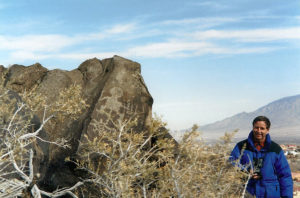
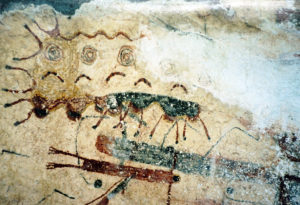
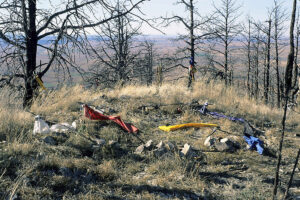
John was a bit of a mystic, and he was very much interested in the philosophies of past mystics – Rumi, Zarathustra, The Buddha, Jesus, Muhammed, Francis of Assisi, Walt Whitman, to name but a few.
Some of John’s thoughts about philosophical, religious, and spiritual issues are explained in the following letter to his girlfriend Jane Edsall.
Life is not simple. On one hand, all is one, and the universe is the ultimate simplicity from this viewpoint. At the same time, the universe is overflowing with multiplicity. When we talk spiritually, we focus on the simple unity. When we talk about things related to physical survival, we focus on the multiplicities. After all, a person rapt in the bliss of unification makes a poor hunter, gatherer, or farmer. But must we be one or the other? Do we have to choose between a spiritual life and physical sustenance? It seems to me we can incorporate both into our life.
At certain times (and I’d like to make them more frequent) I consciously choose to dwell in the bliss of ego-less rapture. Most weekdays during work hours, I choose a different mind set. I do not see a contradiction in this. Both are correct. Neither by itself is enough to live life well. If you only use one, you either quickly starve in ecstatic rapture or prosper physically while living in spiritual impoverishment. Some in India do the former, and many in America do the latter. I consider it childish to stick with only one. Are we really such small creatures that we can only handle one? I can handle more. Anyone who considers themselves an adult should be able to handle more. Of course, how many people are true adults?
We have our very minds and values structured by our upbringing, whether we know it or not. Often our parents give us a simple vision of life, and we grow up with an innate assumption that life is not much more complicated. We may think our parents’ generation was wrong about many assumptions and values. Yet few people I know really grow up to view the world as much more complex, than they were taught. They have switched labels, but not really grown.
In my experience, rationality vs. irrationality, or logic vs. intuition/inspiration, is the conflict that usually lies at the heart of these situations. Most people believe that either one or the other is the correct way to live. Some people think that the litmus test of ‘reality’ must be that something is logical. Other people believe that logic is the perverted tool of evil technologists and should be rejected in favour of the superior method of learning and apprehending life – intuition/inspiration.
I remember in Philosophy 101 asking the professor, why we should assume that A is true simple because it is more logical than B. Is logic a good reality test? How do we know that logic mirrors the universe? He gave me what I thought was a great answer. He said that no, there is no reason to assume that the more logical proposition is the truer or better one. All we can say about logic is that it is a tool. We can also say that in our experience the tool has proven very useful in a variety of situations, so we would like to keep using it in those situations. On the other hand, perhaps our experience has taught us that in other situations logic is not a good guide, such as in matters of love. Maybe in love we want to consciously choose to ignore logic and follow intuition/inspiration. I like that approach. In other words, we decide what the reality test is, based on our own experience with different situations.
I guess a third mode of ‘thought’ is that of no real thought, but rather the blind assumption of knowledge based on authority. We believe something and live our lives accordingly, because an authority figure told us so. I think this is probably the most common choice of lifestyle. I think A is the truth, because my parents told me so, and so did my teachers and priests. Many people (especially Americans of our generation) have, I think, done a reversal of this. What these traditional authority figures say is now automatically assumed to be false, unless ‘proven’ otherwise. Such people instead believe in a contrary set of ideas, promulgated by other people whom they believe. These people gradually assume the position of authority figures. They start to believe what these people say, simply because it is them saying it. There is not even a conscious choice between believing them, because they make logical sense, or believing them because it strikes a cord with the intuition/inspiration they have come to trust through experience. It is simply, “Oh, he said it, and I believe him, so I believe it.”
The problem is that life is simultaneously the simplest and yet the most complex thing imaginable. In fact, it is so much, so it is unimaginable. The ultimate simplicity can’t be expressed in words. The Tao that has a name is not really the Tao, etc. So, the Zen masters just stress experience. The ecstatic poets hint around it in very terse poetry. Very few modern people are even trying to speak about the cosmic simplicity. There isn’t much mileage in it. Instead they speak about the incredible complexities of life.
Unfortunately, very, very few people speaking about the complexities of life seem to have any real sense of just how complex it is. They reduce it down to bite-size ideas. This finds a much bigger audience for a number of reasons.
1) Few of us were raised on anything more than bite-sized ideas, so we have no conception that truth might be more involved than this.
2) We are creatures of our fast-moving, electronic world and consequently have short attention spans. We have trouble holding our minds on one idea for a long enough stretch to listen to an idea being expressed that is more than bite-sized. The only way to have that happen is if we are seduced by special effects that give our information-eating minds something new to jump to every few seconds. Make it into a TV special with camera shots that change every 3.5 seconds, and we will sit and listen contentedly for an hour to the words discussing this complex idea. But even then, better if the message is still simple. Ask anybody.
If an analysis full of bite-sized ideas does justice to the complexity of life, it will not be a bite-sized analysis. Therefore, people will not listen to it. This is the major failing of the scientific press. It becomes my sound bite vs. his sound bite. People will not allow in more than a sound bite at a time. But if it conflicts with an idea, to which they are emotionally attached, they will respond and attack that bite-sized idea, with considerably longer attention span in their attack. In other words, they will insist on limiting new information to sound bites, but their rebuttals of that information will be allowed to run on to the length to which their adrenaline takes them, when a precious idea is threatened by the sound bite. Thus they win. This pretty much guarantees that the listener will get to maintain their status quo undisturbed. This reaction seems to me absolutely epidemic in our society.
The only common exceptions I see to the above rule of thumb regards information from an authority figure, which reinforces the positions to which the listener is emotionally attached. Suddenly everyone’s attention span lengthens in these situations. The result is that most long-term communication in detail is that of the ‘prophet’ speaking to the converted. And let’s face it, very little new information or social change occurs, when someone is speaking to the converted.
My Indian philosophy teacher at Stony Brook told us (whether true or apocryphal I do not know) that when ‘in the old days’ a pair of sadhus met, they would speak. If they found out that they disagreed, they would sit down and talk more, and would not rise from the spot until they felt the same way, whether it was a day or a week or two weeks. Their egos were not fastened to their beliefs, but they were passionately seeking truth. So they each wanted to find out, if the other knew something they didn’t, or had a different interpretation of something they had never thought of, etc. I always thought of this as an ideal way to live. Not to feel threatened by other ideas or even a realization that some of my ideas were wrong. Rather to be thrilled to the marrow at a chance to grow. Growth doesn’t come from listening to a repetition of something you already believe. That breeds security, but not growth.
It can also breed arrogance and prejudice, bigotry and closed-mindedness. When you and everyone you know has been believing the same things for a long time, you come to assume that the collective ‘you’ have cornered ‘the truth’. Anyone who thinks or lives differently is wrong, delusional, possibly self-destructive, maybe even the enemy (especially if they are preaching their ideas).
Yet almost all such judgements are based on the ultimate delusion – that the universe’s ultimate multiplicity and complexity can be accurately comprehended with bite-sized ideas. Because almost no one is dealing in any larger-sized ideas. And bite-sized ideas are almost destined to be incorrect, because it is asking the universe to come down to the level of our human laziness. I do not say human ‘limitations’, because clearly we can hold ideas and beliefs much bigger than bite-sized. It’s just that most people can’t be bothered to. Yet they will be bothered to pass judgement on the ideas of those who do go beyond the bite-sized stage. They will insist on a bite-sized summary from this person, and promptly (even self-righteously) reject it in bite-sized form – usually on the basis of information they absorbed on the basis of blind authority.
When I debated competitively, there were two major ways to attack someone. The simplest (and the one I followed in the early years) was to let my opponent read his references for his ideas when he promulgated them. Then I would get up and read opposite opinions from my own references and pronounce that I had just proved my opponent wrong. There was no real thought involved here. It’s the lay equivalent of the Old Testament’s, “My God’s tougher than your God, and if you don’t believe me, he’ll send us (His People) to slaughter you and yours.” When I got to observe better opponents in regional tournaments I saw there was another way. Attack your opponent’s thinking. Show the flaws in his reasoning, show their self-contradictory nature. This approach at least involves thinking. It expands your mind.
As I tried to explain to you at the Manhattan Indian restaurant last month, this is far more than an intellectual matter with me. Most of the evil in the world is propagated only because people conveniently decline to subject their own beliefs to tough scrutiny. If they would do this and see themselves from the other guy’s point of view, and vice versa, they would realize that most conflicts are a matter of conflicting prejudices – not good and right vs. evil and wrong.
Mark Twain correctly (in my opinion) pointed out that for nearly all people, killing other people is abhorrent. You cannot raise enough natural killers to fill an army. You can only fill a big army and go to war by convincing individuals that they have to overcome their natural aversion to slaughtering someone, who is not currently threatening them. You can only get people to do this by convincing them that they are good, and the other guy is evil. Therefore, they must do the unnatural in the cause of good. They must overcome their natural and healthy aversion to killing, because it is necessary to stop the evil.
I very much believe in a life the way life used to be, and still is in many remote areas. There is no reason that we should not all be able to walk up to a perfect stranger and announce that we are hungry or thirsty, and not expect food or water to be cheerfully proffered. This is living according to the assumption that we are all brothers. We should think long and hard before breaking this pact/assumption. We should not lightly label anyone else as the enemy. It is divisiveness that shatters the quality of life. I want to stress brotherhood and unification. I find it more emotionally uplifting, and I find it to be more accurate, based on my deepest experiences with reality.
However, almost none of us were raised that way. We grew up in an us-versus-them world, and our thinking was colored accordingly. Trading one us-versus-them for another us-versus-them does not do much to raise the consciousness or quality of life for anyone. Yet that is the kind of trade we make, when we drop our old villains for new ones, but continue to focus on the villains and their evil, bastardly deeds. Sure, there are villains, and stopping them helps the rest of us, but we should not lightly spend our time and emotions concentrating on villains and villainhood. If we do, we can never evolve. We can never get to brotherhood by blaming our lack of it on villains.
If we want to have brotherhood and unity, we must spend as much time as possible focused on that.
But just as most of us do not want to focus on the great, simple unity too much, neither do most of us want to focus on the true degree of complexity in our world. Then there would be no easy answers. Then answers would involve hard work. And, damn, I’m busy with my life, I don’t have time to get thoroughly into everything I want to know about. So I choose an expert I trust and I listen to him. That is very dangerous! Before I (JB) personally will do this, I will at least want to subject that expert to a whole series of reality tests. What does he say about something that I am an expert in? Is he mostly right on that? If not, how do I know he is not just as off base on everything else he talks about?
The one plus side of the specialization in science is that at least a person often manages to become an expert in their tiny field. They publish papers about trivial details that most people have no interest in, but they are likely correct about those details. On the other hand, people who only summarize lots of such studies and details may or may not be experts and may or may not get it right. At least the scientific press also has peer review. It means that several other experts on the subject must review the study in question and approve its techniques, its reasoning, and its conclusions before it can be published. It provides some protection against distortions.
Of course, science is frequently wrong about some aspect of the universe. Does this mean that science and the rational thinking on which it is based is all wrong too? Does this mean that we should reject this method and reject rationality with it? I think of Einstein vs. Newton. Newton coined what were considered the ultimate laws of motion. The world’s engineers used them successfully for all kinds of things. Then Einstein showed that Newton was only correct for the common case. In extreme cases, like huge distances or very high speeds, Newtonian mechanics was wrong. Yet 40 years later astronauts went safely to the moon and back, using only Newton’s laws. Even at those speeds and distances they could ignore Einstein. In other words, Newton may not have been completely correct, but his laws are damn useful and accurate enough for most situations. So we can choose to use him in those situations (even though he technically is wrong) and ignore him in others (astronomy, and the universe at large), because it is very useful to do so and accurate enough for our purposes.
It seems to me that when we insist that ‘truth’ be all encompassing and right in every case, we expose our childish nature. As kids we felt secure only because we thought this was true. We assumed that Mom and Dad understood how the world worked and would protect us from it and guide us through it, until we could understand it ourselves. Had we believed that neither Mom nor Dad had much of a clue as to what was going on, that in fact no one did, we would have been terrified.
I once heard a survivor of the great Hurricane of ’38 tell about how their beach house was being pulverized by rising surf, but she was not worried, because her father had his shoulder to their front door, keeping it shut against the breakers now pounding their house. She said of course as an adult she realized it was absurd to think her father could have kept out the ocean. But as a child she just assumed it. She told the camera that the moment a wave finally broke through the door and threw her father across the floor was the moment her world changed forever.
I don’t think most of us are willing to accept that degree of change. When we realize that Mom and Dad don’t understand the entire world well enough to protect us from all harm, we go looking for someone who does. Then we listen to them and feel secure again. We’ve got a handle on the world again.
No one understands the world that well. Some people know certain things, but are ignorant of or wrong about others. If we are mostly interested in feeling good, we ignore this shortcoming. If, on the other hand, we are truly interested in understanding existence, we realize that we have to pick and choose, think for ourselves, investigate for ourselves, and still maybe never be sure about some of the things which are most important to us.
In this kind of searching, it pays to play devil’s advocate with yourself, to question your own assumptions and biases. Because all of us have biases and operate from certain basic assumptions. If we do not get to know our own, we will be forever fooling ourselves about what we are really doing in life.
It is not easy to discover your own bias, so often I try to focus on those of mankind as a whole (assuming I’m likely to share some of these). All mythologies have always talked about a Golden Age in the past, when Man was close to (even talked to) the animals. Then we got distant from the world, and evil befell us. The reason such stories become durable myths is that they emotionally connect with us. We identify with a Golden Age deep in our past (probably our dimly remembered early childhood, maybe even the womb). We all want to go back to that Golden Age. This makes us easy marks for anyone or any belief that promises to return us to the Golden Age.
That is just one small example.
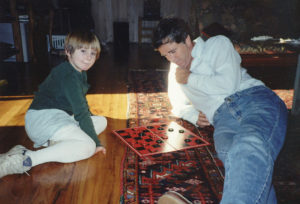
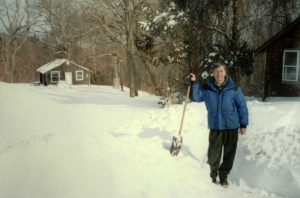
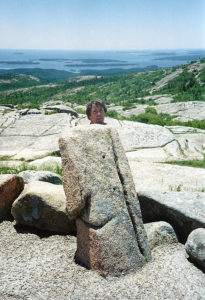
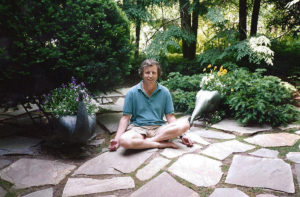
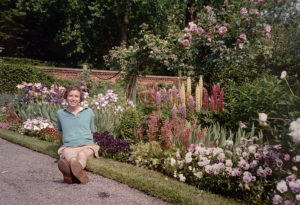
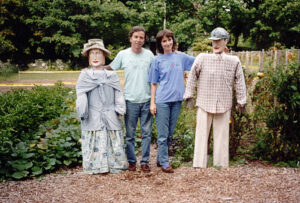

In September 2001, John and I traveled together to Lake Champlain, Fort Ticonderoga and other localities in up-state New York, and on to Quebec, to see some of the sites, where Benedict Arnold and his men fought crucial battles against the British during the Revolution.
Unfortunately, John never succeeded in getting his novel published. Below is his introduction to the novel, describing his efforts to unearth the correct historical facts.
The entire novel can be read elsewhere on this website, see Rose of the Revolution.
Historian Pennypacker’s work was concluded on Patriot’s Day in 1964 as an historical marker was unveiled at Robert Townsend’s grave, rifles fired a long overdue salute, and the American flag fluttered in the breeze. I was the twelve-year-old Boy Scout holding the flag on that day, and for me it began a never-ending fascination with this long-dead man and the great events, which unfolded in both my small home town of Oyster Bay and my birthplace of Manhattan. Only as an adult, however, would this interest lead me to stumble on the mystery woman at the eye of the storm and the even more secret side to this long-secret story.
Most of the events described here took place in Manhattan, Long Island, and the Hudson Valley. The City of New York in the American Revolution endured the longest occupation by a wartime enemy army of any city in modern history. During these years, the average resident suffered hardships beyond our comprehension. They were forced to find ways to improvise and make do in a frightening situation over which they had no control. Worst of all, however, was the lot of anyone labeled a traitor by the British authorities. The treatments reserved for them would result in war crimes trials today. Yet, through all of this, a few Patriots chose to remain in New York, engaged in the most perilous pursuit of all – espionage. Their role was that of mice in the lion’s cage, and at times their chances of victory must have seemed just about as likely. History, of course, has been the final judge.
Getting all the facts straight hasn’t been easy. There seems to have been an invisible, sometimes cloak-and-dagger resistance against bringing this long-suppressed story to the public. Just before Pennypacker’s book went to press, several chapters of the manuscript were stolen from the safe in his publisher’s office. Taken as well were the original Revolutionary War letters from Robert Townsend’s sister Sally – a key figure in the hot debate about what really happened when Benedict Arnold committed treason.
I ran into similar problems. During the lengthy research necessary for this book, I sometimes began to feel like a detective re-opening an old case only to find that important pieces of the original evidence had somehow vanished before I got there. Many of historian Pennypacker’s original documents have mysteriously disappeared from the East Hampton Library archives. Pennypacker himself came back and removed some not long before his death, at a time (in his mid-nineties) when he badly needed money. Their fate remains a mystery. Other documents have simply been stolen from the archives by persons unknown.
This intrigued me even more. Oyster Bay in the twentieth century was, after all, not unlike Oyster Bay in the Colonial era. It is a staid town of old money families and values. Scandal has always been un-welcome, but present. When I was a child, we played in the abandoned ruins of the Woodward estate, and gaped at the shotgun blast still visible in the wall, where (it was said) a gold-digger’s wife blew the head off her wealthy, high-society husband before he could divorce her. According to two books and a TV mini-series about it, his family – incredibly – protected their son’s killer rather than allow a scandal to develop. It seems they may even have gotten the Duke and Duchess of Windsor to lie to the police about it, all in a desperate effort to stave off sensational headlines. That is how badly old families here fear scandals.
Finally, even during the American Revolution, cover stories were invented for the events contained in this book. In espionage this is frequently necessary. As a result, what has faced any truth seeker has been the proverbial riddle wrapped inside an enigma. It comes complete with fall guys, red herrings, double agents, and invisible ink. Yet modern archives offer sufficient clues that as one orders the events chronologically and examines all the evidence, one begins identifying with the participants and a clear picture starts to emerge. From the fog of contradictions, false statements, and cover ups, we find – among other things – that women (on both sides) played a far more crucial role in the struggle for American Independence than the images of Betsy Ross and Molly Pitcher would have us believe.
While researching this material, I also came to appreciate another ‘secret’ of the American Revolution. Our War of Independence probably could not have succeeded were it not for the limitless bravery and personal genius of the most effective battlefield commander in North America – Benedict Arnold. Inspiring the fledgling nation while George Washington floundered in defeats, he was considered the second greatest hero of the American Revolution – until, that is, he married a beautiful and wealthy woman half his age. Though no one knew it at the time, that moment launched the flamboyant Arnolds on a collision course with another couple – one of infinitely lower profile. At this crucial juncture, when the American cause was experiencing its darkest hour, the question of which couple won would determine whether or not America gained her independence.
While the final effect of their struggle is well known, the personal fates of these flesh-and-blood participants have remained too long in the shadows. I have tried to let these very real individuals speak for themselves. Since some specific conversations and personal incidents are unknown, I have added a little of my own imagination in those instances, but only to flesh out the known developments. Historians always have and always will argue among themselves about what really happened at any point in the past. What can be said here is that all significant historical incidents herein seem to have happened as described and are documented directly or indirectly by information in historical archives. The picture which emerges is the only one offered to date that is consistent with all the evidence. Such cannot be said of the other versions – even the ones in the history books.
Today, as privileged citizens of one of the great democracies, we should know the true stories of a handful of real people who stepped forward when needed, prepared to make the ultimate sacrifice, and who wrestled unseen over the fragile balance of power at a time when the lifeline of our infant republic dangled precariously. It is their daring, their shrewdness, their dedication – but most of all their passionate love for one another – that burns them into the memory and fires the imagination.

